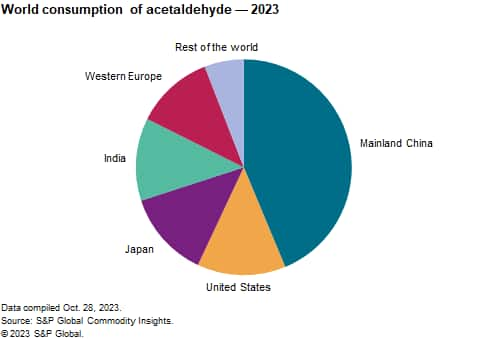Published December 2023
Acetaldehyde is an important chemical intermediate. Three processes are currently being used for commercial production of acetaldehyde – liquid-phase oxidation of ethylene, production from ethanol and hydration of acetylene. Of the known capacities and processes, about half of the global capacity for acetaldehyde uses ethanol as a raw material, mainly in mainland China and India. About 40% is via the oxidation of ethylene, mainly in the United States, Western Europe, Japan and the Middle East, while only about 5% of capacity uses acetylene as a raw material; all of the known plants are located in Eurasia.
The following pie chart shows world consumption of acetaldehyde:

Mainland China is the largest consumer of acetaldehyde, followed by the United States, Japan and India. World consumption of acetaldehyde is forecast to grow at about 2%-3% per year in the next five years (2023–28). Capacity and consumption growth continue to be mainly driven by Asia, particularly by mainland China and India. India is the most active consumption market and is expected to see the highest growth rate in the forecast period. As a result, India could become the second-largest consumer of acetaldehyde by 2028. Annualized consumption growth in the United States is expected to slightly higher than in Western Europe, while consumption in Japan will continue to decline.
Ethyl acetate and acetic acid were once the largest uses for acetaldehyde, but these markets have largely shrunk as other lower-cost processes are used preferentially. The large-scale industrialization of methanol carbonylation to produce acetic acid, which offers lower production costs than the acetaldehyde process, has led to the gradual phase out the ethylene–acetaldehyde–acetic acid production route.
Acetaldehyde consumption for pyridines and pyridines bases has become the largest market, followed by pentaerythritol. Other consumption uses include production of crotonaldehyde, 1,3-butylene glycol, glyoxal and pharmaceuticals.
For more detailed information, see the table of contents, shown below.
S&P Global’s Chemical Economics Handbook –Acetaldehyde is the comprehensive and trusted guide for anyone seeking information on this industry. This latest report details global and regional information, including

Key benefits
S&P Global’s Chemical Economics Handbook –Acetaldehyde has been compiled using primary interviews with key suppliers and organizations, and leading representatives from the industry in combination with S&P Global’s unparalleled access to upstream and downstream market intelligence and expert insights into industry dynamics, trade and economics.
This report can help you:
- Identify trends and driving forces influencing chemical markets
- Forecast and plan for future demand
- Understand the impact of competing materials
- Identify and evaluate potential customers and competitors
- Evaluate producers
- Track changing prices and trade movements
- Analyze the impact of feedstocks, regulations, and other factors on chemical profitability

















